The old Sea Gull Cellar Bar really was a cellar, a hole in the ground carved out below the dining room and accessed via a spiral staircase from inside the restaurant upstairs. That staircase was the bane of many waitresses and waiters who ran up and down to retrieve and deliver drinks. There was no dumb waiter in those days. There was also a front door and a back door from the Cellar Bar leading outside.
A simple method was used to pump the slop water from the bar sinks to the sewer pipe that ran above the bar. Outside the back door there was a holding pit where the water gravity-flowed from the bar sinks. Inside the holding pit there was a sump pump. The pump was activated by a float mechanism. When the water reached a certain level, the pump would switch on and swish went the slop up to the sewer line. You could hear the pump when it was working from inside the bar, a mild buzzing sound followed by “Harrumph” when it switched off. If it went on the blink, the sink water would start seeping up outside the back door.
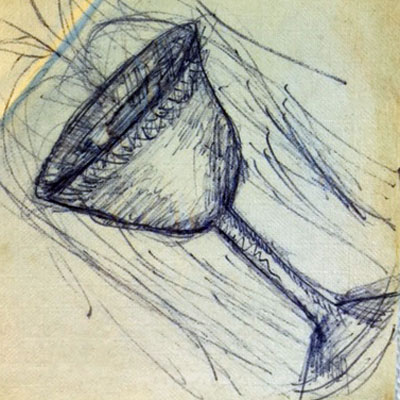
Napkin Art, Sea Gull Cellar Bar, artist unknown
The ice machine was also outside the back door. A window above it opened out from the bar for ventilation. One morning I came down the back stairs to open the bar and saw the window had been smashed. The bar door was unlocked. Everything except the window appeared to be untouched. I looked around and noticed an empty bottle of bourbon on the bar with an empty glass. Under the glass there was some cash and an unsigned note: “Sorry about the window. Needed a drink. Hope this covers it.”
The Cellar Bar offered its patrons free Japanese rice crackers and fried green peas that were set out on the brass bar tables along each wall. The fried green peas were a favorite but hard on the teeth. The local dentists should have paid a finder’s fee, but they didn’t. Coffee was served from elaborately decorated Zojirushi vacuum insulated air pots that came from the same Japan Town store in San Francisco as the fried peas and rice crackers.
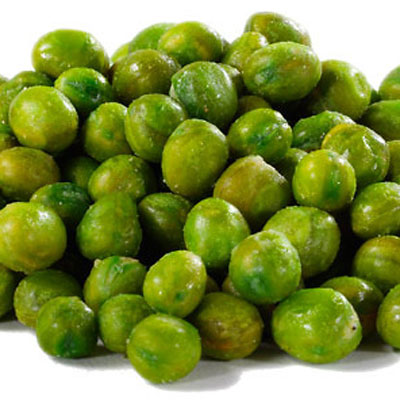
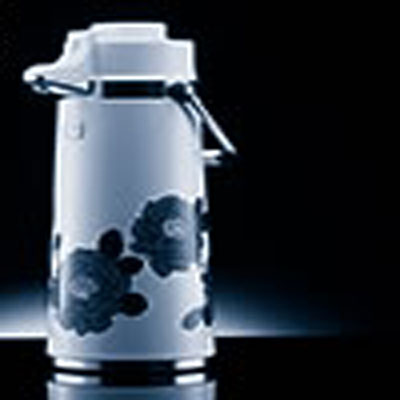
One day Dick Barham informed me that he was sick of washing dishes and wanted a promotion to tending bar. Not long after he became a bartender, he suggested we establish a happy hour. I told him all that would do was prove that if we gave away food and booze, more people would come. He was right though, business not only increased, it proved to be profitable. It also meant more work for him.
Under the spiral staircase there was a refrigerator where beer, wine and condiments were stored. There was no refrigeration in the bar. Large galvanized tubs were filled with ice and kept under the bar sinks where beer and wine and cream were kept for the bartender as needed. When these ran short, it was necessary to walk around the bar up to the front refrigerator to restock. Though hidden by an oriental rug draped around it, the refrigerator was soon discovered and the beer and wine began to disappear. A chain with a padlock had to be used to secure it, one more annoyance for the bartender.
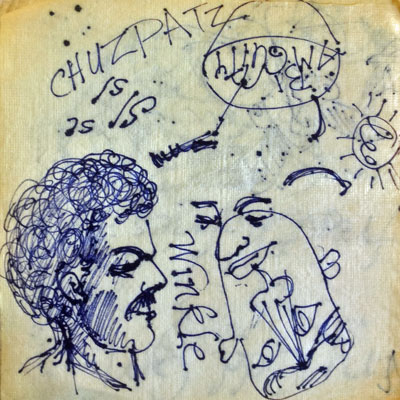
Napkin Art, Sea Gull Cellar Bar, artist unknown
There is a long history of bars in Mendocino. Digging around in the garden behind the restaurant, I found an interesting coin, a 5 cent token for the Joseph Granskog Eagle Saloon in Mendocino City. I’ve seen these tokens offered online for from $300 to $600. Considering Granskog opened his saloon in 1909, that’s a compounded return of 8-9% a year. Not bad, but not as much as you might think. It’s a little less than stock returns over the same period even with the Great Depression figured in. I still have my token. Any offers?
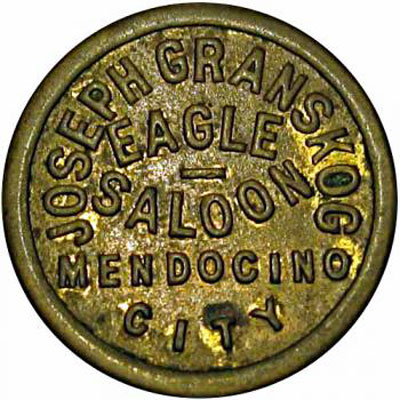
An interesting if racy history of Mendocino bars and night life was compiled by Margi Gomez over at the Kelly House Museum. Go to THIS LINK TO READ IT.
The Cellar Bar opened late in the afternoon but sometimes I would open it during lunch to see what happened and so that I could make cocktails for the lunch crowd upstairs. It didn’t payoff at first but it was a cozy room dimly lit by glass chandeliers that were stained by years of cigarette smoke. This was before it was politically incorrect to smoke. I don’t smoke, and I don’t much like smoky rooms, but there is something about smoking that appeals just the same. Maybe it’s the free advertising the cigarette industry got from all those movies and TV shows where the most interesting and beautiful people smoke. Even today, when the industry is vilified and smokers are treated as badly as atheists, there are some who proudly defend it like one of my favorite new authors, Valeria Luiselli. IN A RECENT INTERVIEW she said:
Luiselli: “You don’t have a lighter, do you?”
Interviewer: “I don’t, I don’t smoke.”
Luiselli: “I’m sorry to hear that.”
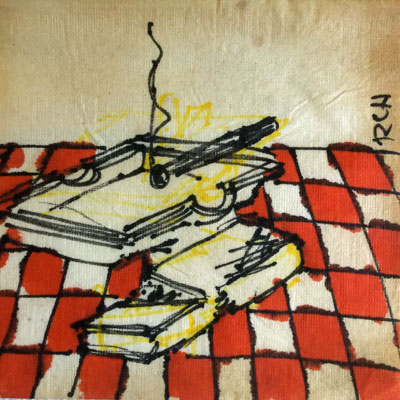
Napkin Art, Sea Gull Cellar Bar, Roy Hoggard artist
I hung out in the Cellar Bar during the lunch rush using the excuse that I’d make drinks for the lunch crowd and maybe drum up some new bar business, but really I was just enjoying myself and allowing myself some time to think quietly away from the crowd upstairs.
When the bar wasn’t busy, you could hear the cars pulling in to park upstairs outside the restaurant. The front windows were blocked with oriental carpets (these were all over the place in the old Cellar Bar including along the walls and on the seats where people sat to enjoy their drinks). Once when I heard a car pulling in, I walked up front and peeked through the carpet to see who it might be. The car was a Cadillac Coupe de Ville with those large fins in the back. Two older women got out, one from the back seat and one on the passenger side. They went in through the front door of the restaurant. I assumed they were going to use the bathroom because the driver stayed in the car. In those days the Sea Gull was one of the few readily accessible bathrooms in Mendocino.
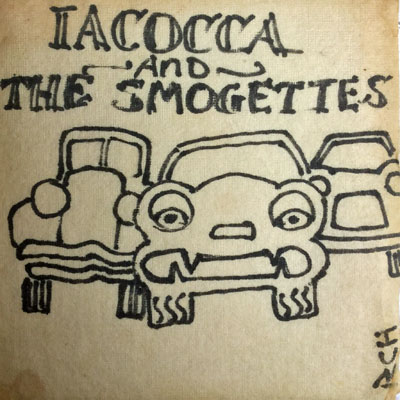
Napkin Art, Sea Gull Cellar Bar, Roy Hoggard artist
As soon as the two were gone, the driver, also an older woman, got out and headed downstairs. I quickly let the rug fall back on the window and went to my perch behind the bar. The woman came in and sat on a bar stool closest to the door. I thought she was probably around 70. She was modestly dressed, hair recently done, elegant jewelry though not conspicuous, and she seemed friendly but reserved.
“I’ll have a vodka straight up, please,” she said.
I poured her vodka and she downed it in a single gulp. I was stunned, but attempted to shake it off as an every day occurrence.
“One more.” She smiled at me as if she wanted to start up a conversation, but she didn’t.
She downed the second one just as fast. “Might as well have one more for the road,” she said in a matter-of-fact tone.
When she finished the third drink, she put her forefinger across her lips. “Shh,” she said with a smile, “this is just between us.” She put a $20 bill on the bar (drinks then were around two bucks a shot, I think), thanked me and hurried out the front door. I waited a minute then went back to the window to sneak another peak. She was sitting in the driver’s seat cool as a cucumber when the other two came out the front door and climbed back into the car. She backed out the car and off they went.
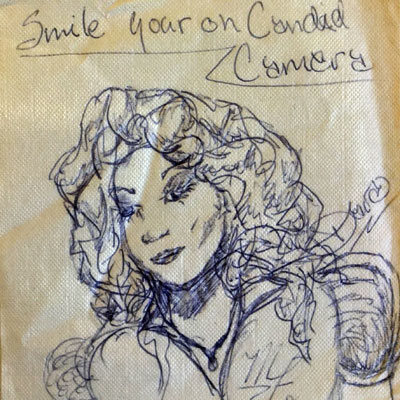
Napkin Art, Sea Gull Cellar Bar, artist NY
One of our most famous drinks was the Dirty Bird. It consisted of a shot of vodka, a shot of tequila, a shot of Kahlua, and a healthy splash of half and half all blended with ice and poured in a tall glass. It tasted like a chocolate milk shake but affected you quite differently. Once I told a bartender in Zihuatanejo how to make them. I went back a few years later and he was still making Pajaro Sucios and serving them to his happy customers.
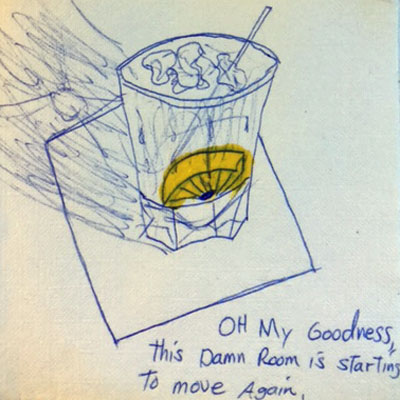
Napkin Art, Sea Gull Cellar Bar, artist unknown
The strangest drink I was asked to make was a Fleet Deck landing: 1/3 dark rum, 1/3 light rum, 1/3 buttermilk. I haven’t ever tried one. It just sounds too odd.
I don’t know how anyone can drink sweet drinks all night. Once after closing I stayed up for a couple of hours drinking Tuaca with Bob Avery and Julie Calouro. Tuaca is a liqueur made of brandy with a bit of orange and vanilla flavoring. It tastes something like butterscotch. The next morning, I had a terrible hangover. Never again.
I remember a huge guy named Tony with long, straight hair and a bushy beard who worked with the band Dirty Legs. He and his girl were regulars. She drank Kahlua and cream and he drank Southern Comfort and Coke. They could sit through half a dozen or more drinks one after the other without even a bathroom run. Then off they went only to return again the next night. There really were such people. Maybe they’re still around, but I haven’t seen them for years.
Another odd drink that I did try was the Liver Destroyer: Wild Turkey with a shot of Chartreuse on the rocks. I liked to call it the rich man’s bourbon and seven.
Drinkers seem to get stuck on certain drinks. Clyde, who owned a vegetable delivery business, always drank Old Taylor and soda before dinner and Green Hungarian wine during dinner. Dinner was always Chicken Kiev. David and Evelyn, well known locals, drank CC & water and CC & 7. If Dennis Hekkala came in early in the morning (we did open early on the weekends to make Gin Fizzes and Bloody Mary’s), it was always for a shot of Fernet Branca to ease his hangover caused by too many drinks the night before. The only person to drink Remy Martin was the previous owner. I acquired a case with the inventory and it took years to get rid of it. Almost everyone drank Metaxa, a Greek brandy, (we had 3 star, 5 star, and 7 star). For a time was THE drink of the in-crowd. Coffee drinks and hot buttered rums were popular when it was cold, damp, and foggy and around the end of the year holidays. We made our hot buttered rums the old fashioned way (no premade paste in a jar): a pat of butter, shot of brandy, dash of triple sec or sugar water, piping hot water, a stick of cinnamon and a clove or two.
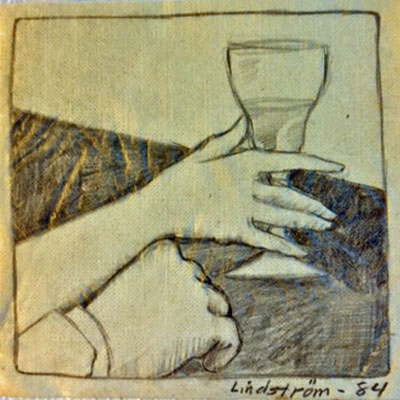
Napkin Art, Sea Gull Cellar Bar, Sandra Lindstrom artist
There were some unusual items in and about the old Cellar Bar—a blowfish high on the back wall, a rhinoceros foot on one end of the bar, a porcelain Sairey Gamp plate, numerous stuffed animal heads, oriental carpets, several smaller paintings, and a few large oil paintings. Most of these burned up in the 1976 fire but the rhinoceros foot survived. I had removed it from the bar to use in the house next door as a place to store my tips. After the new restaurant was operating, I passed it along to James Maxwell when he completed the last of his wonderful oil paintings that filled the spaces between the rafters in the new bar.
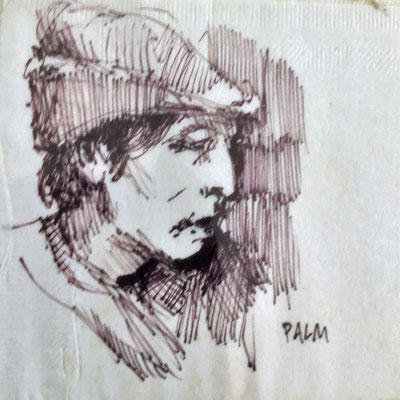
Napkin Art, Sea Gull Cellar Bar, Olaf Palm artist
Bartending was a complicated job in those days. The ABC (Alcoholic Beverage Control) required that all liquor bottles be broken when emptied so they could not be used again, presumably re-filled with something other than indicated by the label. Under the bar we had bottle breakers, metal shafts that stuck out from the wall. When a bottle was emptied the bartender shoved the neck of the bottle onto the shaft and pushed down to break the bottle with the broken glass dropping into a garbage bucket. The result was that bartenders lost a lot of blood. Then there were the fruit flies. If we kept tops on the bottles to keep the fruit flies out, it slowed things down considerably on a busy night. However, just one fruit fly discovered by the ABC or health inspector would result in the entire bottle being poured down the drain. Straining the bottles was illegal. The job was fraught with moral and ethical dilemmas.
Customers came in packs. Listed in approximate chronological order, there were the school employees in one group, the carpenters (especially sheet rockers) in another, the musicians, the employees from other restaurants, and the solitary cats that don’t roam in herds, that is, most everyone else in the Redwood Empire.
“To found a great empire for the sole purpose of raising up a people of customers may at first sight appear a project fit only for a nation of shopkeepers. It is, however, a project altogether unfit for a nation of shopkeepers; but extremely fit for a nation whose government is influenced by shopkeepers.” Adam Smith, The Wealth of Nations
Well, the shopkeepers came in too.
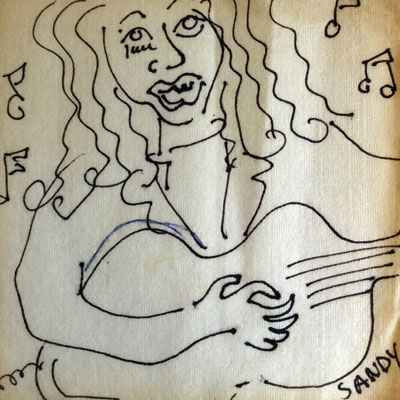
Napkin Art, Sea Gull Cellar Bar, Sandy artist
The old Cellar Bar was poorly organized for live music although we had several gigs that jam packed the room. Most of the time the music consisted of LPs (remember those) blasted out from an antiquated phonograph player under the bar. The music was chosen by the bartender. A bartender leaving a shift could sabotage the incoming bartender with the right choice of music. I always saddled Dick Barham with Jimmy Buffett’s Let’s Get Drunk and Screw. I still hear about that today.
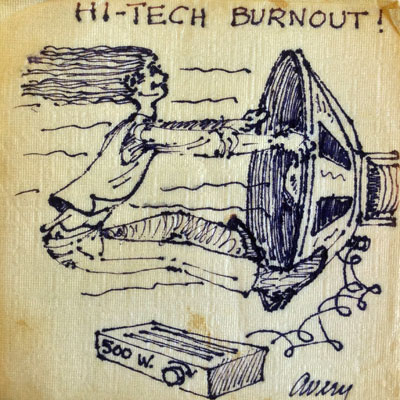
Napkin Art, Sea Guil Cellar Bar, Bob Avery artist

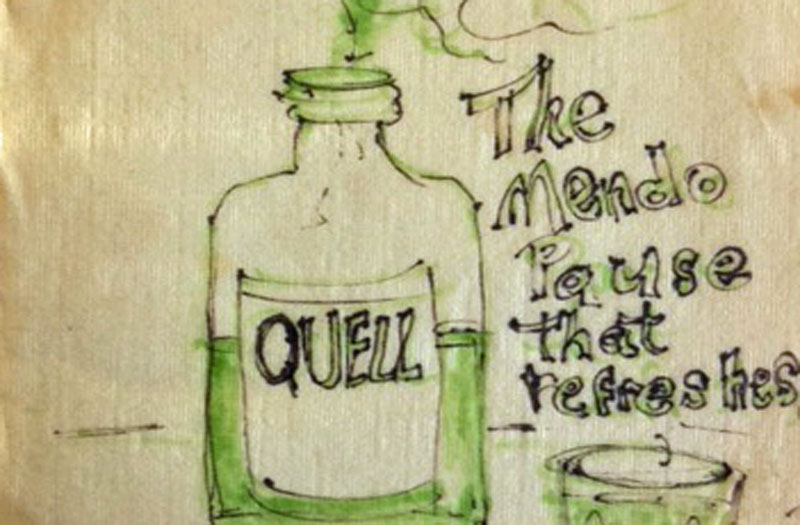
Wonderful stories, David.
As a bartender in the cellar bar in 1971/72, I remember a lot of your stories. I especially remember Martin, the prior owner of the Seagull, who would come down to the bar with his coffee cup and ask me to fill it with Remy Martin. Martin would do that several times on some nights and return to the restaurant upstairs. I also remember Tony and his friend who could drink as much as 10 Southern Comfort or kahlua drinks.
David Clayton and I spent many an evening discussing this or that in that bar. It was a great, great place for those conversations…